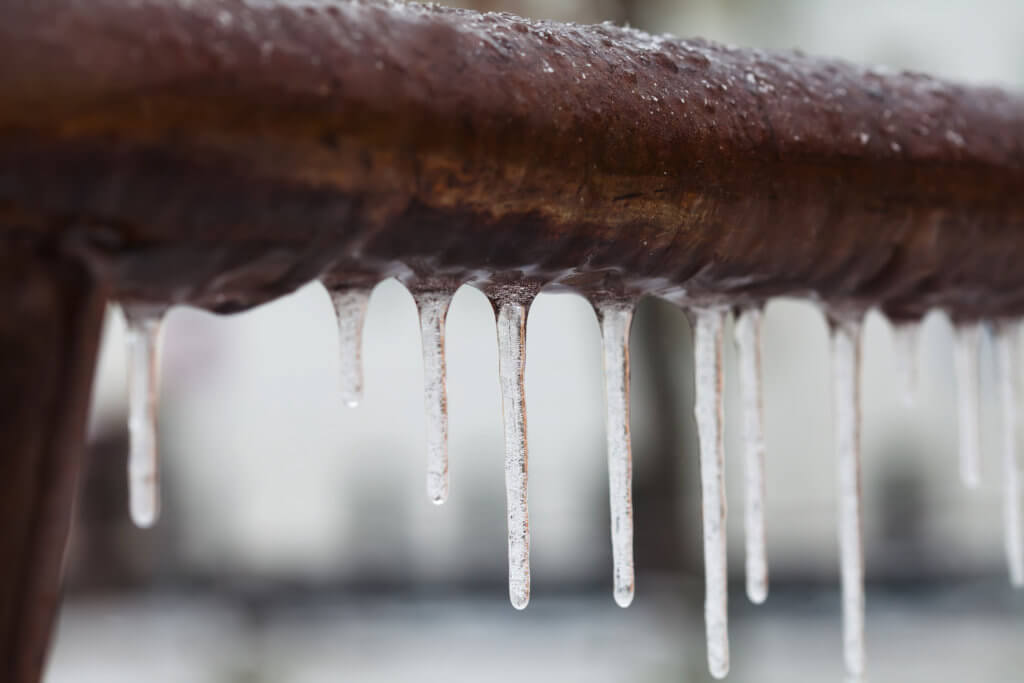How to Prevent & Thaw Frozen Pipes
January 5, 2018

Much of country is experiencing freezing temperatures, prompting comparisons to Mars and the South Pole. While experienced Colorado homeowners know all too well the dangers of frozen temperatures on their home and plumbing systems, many newbies have learned the hard way this winter and will have to learn how to prevent and thaw frozen pipes.
When temperatures dip below freezing, you run the risk of frozen pipes. And as we all know, once water freezes, it expands. This expansion can cause cracks, ruptures, and massive water damage. One of the first indications of a frozen pipe is reduced water flow from your faucets. Take careful note of your water pressure during cold, winter weather. Especially in the early mornings and late nights.
Remember, your pipes are in danger of freezing whenever the temperature drops below 32°F.
In addition to paying attention to water pressure and flow, you want to take extra precautions to prevent frozen pipes.
How to Prevent Frozen Pipes
Drain Outdoor Water Pipes
To prevent your garden hose, irrigation systems, and pool components from freezing, we recommend disconnecting and storing all of your outdoor hoses and draining water from sprinklers and irrigation systems. This is also a good time to drain the gas from any gas-powered yard equipment and store them inside for winter.
To drain your outdoor faucet, turn off the individual shut-off valve for the outdoor faucet, then leave the faucet open to drain any excess water.
If you intend on using your outdoor faucet during winter, consider installing a freeze-proof sillcock on your outdoor faucet. You can also purchase insulated faucet covers online or at your local hardware store.
Insulate Your Pipes
Check the water pipes for insulation, especially in unheated areas of the home such as crawlspaces.
Consider insulating your vulnerable pipes in basements and crawlspaces with slip-on insulation sleeves from your local home improvement store. Place the insulation sleeves flush against each other and use tape to seal them together.
There are other ways to insulate your pipes, but slip-on foam insulation tends to be the easiest. Remember to clean and dry the pipes completely before applying any pipe insulation.
You can also find a special electrical tape that contains a thermostat for your most vulnerable pipes. This electrical tape is plugged into an outlet and automatically turns on when it senses freezing temperatures. You can find special electrical heat tape with thermostats online or at your local home improvement store.
Leave a Trickle of Water
If temperatures are dipping below freezing, leave a small trickle of water running from your faucets. Turn on both the hot and cold lines to release pressure and keep the water flowing inside of your pipes. Flowing water is nearly impossible to freeze.
A few lost gallons of water is a lot better than costly frozen pipes that could lead to bursting and extensive water damage.
Leave the Heating System On
Thinking of saving on energy costs, many people choose to turn off the thermostat when leaving the home for extended periods of time. In general, this could be a good idea, but not when it’s freezing out.
To be safe, set the thermostat no lower than 55°F, especially if you will be away from the home for a long time. Frozen and burst pipes are a lot more expensive than a couple extra dollars on your heating bill.
Leaving the heat on will also prevent your foam mattress from turning into a rock-hard slab.
Open Up Cabinets
If you have any pipes hidden away in cabinets (bathrooms and kitchens), leave them open during freezing temperatures to help circulate warm air.
Close and Insulate the Garage
If you have pipes in the garage, it is highly recommended that you invest in some garage insulation. You may also want to install a heating system in the garage, especially if you plan on using it in the winter. One of the best heating systems for the garage is a ductless mini-split heat pump.
Some tips for insulating your garage include:
- Adding and/or replacing weatherstripping around the garage door.
- Insulating the garage walls and door, such as with foam boards or fiberglass batt insulation.
- Fixing the garage door and any large gaps or cracks.
Little improvements will make a big difference.
Leaving On Vacation?
If you are leaving the home for more than a couple weeks, your best bet is to drain the entire plumbing system. Simply turn off the main water supply and leave all of your faucets open. Don’t forget to flush the toilets.
Finish things off by pouring some plumbing antifreeze into the toilet bowls, sinks, tubs, and drains. About a pint for your toilets and half a pint for your drains.
Remember to close off outdoor faucets to prevent pests from entering the home.
How to Thaw Frozen Pipes
Despite preventative measures, sometimes pipes will still freeze. The Denver area in particular experiences multiple deep freezes during the year.
If your pipes start to freeze or have already frozen, there’s still a way to prevent them from bursting and destroying your home and pipes.
One warning sign of freezing pipes is weak water flow. The sooner you learn of a frozen pipe situation, the sooner you can fix it without damage.
Do NOT Use Open Flames, Boiling Water, or a Hammer
You may have run across the suggestion to use a torch or some other kind of open flame for thawing pipes, but this can be highly dangerous and destructive.
It’s also not a good idea to pour hot water on the pipe as this water can freeze on the outside of the pipe and can cause steam to rupture the pipe.
Additionally, do not try to break up the ice with a hammer or any other object. This can easily cause your pipes to crack.
Warning: Do NOT use an open flame, such as a torch or candle. Do NOT pour hot water on the pipes. Do NOT bang or strike the pipes to try and break up the ice.
Turn on your faucets
Whether or not you have water still flowing through your pipes, it’s a good idea to turn on your faucets so that when the water thaws, it has a place to go. It will also release pressure and facilitate the thawing process.
Turn off the water supply
Learn where your individual and main water shut-off valves are located first. If you know where the frozen pipe section is and there is an individual water shut-off valve, go ahead and turn it off.
If you cannot locate your individual water shut-off, you can turn off the main water shut-off valve. Once you have turned off the water to the frozen pipe section, you can proceed to thaw your pipes.
Thaw frozen pipe sections
There are several different ways you can thaw your frozen pipes without resorting to an open flame:
- Hand-held dryer (moving back and forth around frozen section)
- Electrical heating tape (wrap around pipe, plug into an outlet, and remove once pipe has thawed)
- Hot-water-soaked towel (heat up water, get a towel wet, wring it so it’s not dripping, then apply to frozen section)
We also recommend turning up the thermostat and leaving an electric space heater nearby to facilitate the thawing process.
When the pipes are thawed, you can turn the water supply back on.
Professional Frozen Pipe Solutions
Sometimes, the best method is calling in the professionals, especially if you have inaccessible pipes, including unground pipes. A professional plumber will be able to safely and successfully prevent and thaw your frozen pipes.
One method includes installing a heating cable that resides inside of the pipes. This is connected to a thermostat to prevent pipes from freezing when the temperature dips below a certain level.
If you have any questions or doubt about how to prevent or thaw frozen pipes, don’t hesitate to call your local plumber.
Schedule your winter heating and plumbing maintenance service in Denver today, or sign up for our home maintenance plan, the Fix-It Green Club.
When Your House Is in Trouble, Call the Green Bubble!
(303) 214-0277
Service You Can Count On
We came from humble beginnings, having started as just a small family
business. And while we’ve experienced growth, Fix-It 24/7






